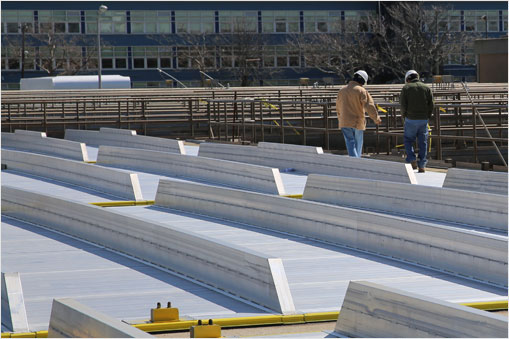 May 20, 2014 CONTACT: deppressoffice@dep.nyc.gov, (718) 595-6600 Department of Environmental Protection Installs New Odor Control and Air Filtration Systems at the Rockaway Wastewater Treatment FacilityPhotos of the Work Can be Viewed on DEP’s Flickr PageNew York City Department of Environmental Protection (DEP) Commissioner Emily Lloyd today announced that new odor control and air filtration systems have been installed at the Rockaway Wastewater Treatment Facility. Located along Beach Channel Drive in Rockaway Park, and across the street from the Scholars Academy, the facility has the capacity to receive and treat to federal Clean Water Act standards up to 45 million gallons of wastewater each day. As part of the approximately $1 million project, 205 aluminum panels were installed over nearly 6,500 square feet of outdoor tanks where, as part of the treatment process, the wastewater is stirred up and can create odors. In addition, the trapped air will now be pulled from the tanks through a new ventilation system and put through an activated carbon filtration process that removes any odor producing particles and chemicals before the clean air is then released into the atmosphere. To further improve air quality DEP has also planted nearly 100 new trees around the perimeter of the plant. “The proper collection and treatment of wastewater is absolutely essential to both public health and our natural environment,” said DEP Commissioner Emily Lloyd. “Working with local leaders, we are pleased to make this $1 million investment in new odor control and air filtration systems at the Rockaway Wastewater Treatment Facility that will ensure that we continue to protect Jamaica Bay with minimal disruption to our neighbors.” “The odors from the wastewater treatment plant have been a nuisance for families in Rockaway,” said Assemblyman Phil Goldfeder. “This is a huge step forward for our community and I commend DEP for taking the necessary actions to ensure our air is clean and healthy for our neighborhood and children.” “This is great news and long overdue,” said Councilman Eric Ulrich. “These improvements will go a long way in providing some relief from the odors that often drift over the peninsula. It is my hope that these improvements will be the first of many that will be implemented at the treatment plant as it is repaired and hardened against future storms.” “We are always grateful to the DEP for responding to DOE and parent concerns regarding the atmosphere around our school buildings," said DOE Deputy Chancellor of Operations Kathleen Grimm. "These improvements to the Rockaway Wastewater Treatment Plant will provide a more pleasant environment for our students, our staff, and the neighborhood of Rockaway Park. Especially for a part of New York City so affected by Hurricane Sandy, we appreciate the DEP’s efforts.” The Rockaway Wastewater Treatment Facility went into operation in 1952 and receives wastewater from the more than 90,000 New Yorkers living in, or visiting, the Rockaways. Over the last decade DEP has invested more than $10 billion to upgrade and enhance the capacity of the City’s 14 wastewater treatment plants and the health and cleanliness of New York harbor continues to improve to levels not seen in more than a century. DEP manages New York City’s water supply, providing more than one billion gallons of water each day to more than nine million residents, including eight million in New York City. The water is delivered from a watershed that extends more than 125 miles from the city, comprising 19 reservoirs and three controlled lakes. Approximately 7,000 miles of water mains, tunnels and aqueducts bring water to homes and businesses throughout the five boroughs, and 7,500 miles of sewer lines and 96 pump stations take wastewater to 14 in-city treatment plants. In addition, DEP has a robust capital program, with nearly $14 billion in investments planned over the next 10 years that will create up to 3,000 construction-related jobs per year. This capital program is responsible for critical projects like City Water Tunnel No. 3; the Staten Island Bluebelt program, an ecologically sound and cost-effective stormwater management system; the city’s Watershed Protection Program, which protects sensitive lands upstate near the city’s reservoirs in order to maintain their high water quality; and the installation of more than 820,000 Automated Meter Reading devices, which will allow customers to track their daily water use, more easily manage their accounts and be alerted to potential leaks on their properties. For more information, visit nyc.gov/dep, like us on Facebook at facebook.com/nycwater, or follow us on Twitter at twitter.com/nycwater. | ||